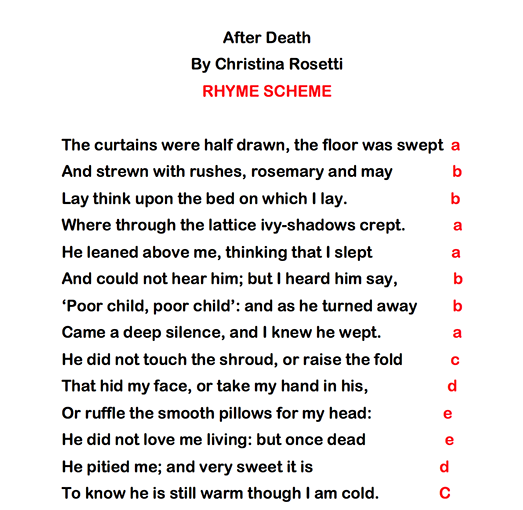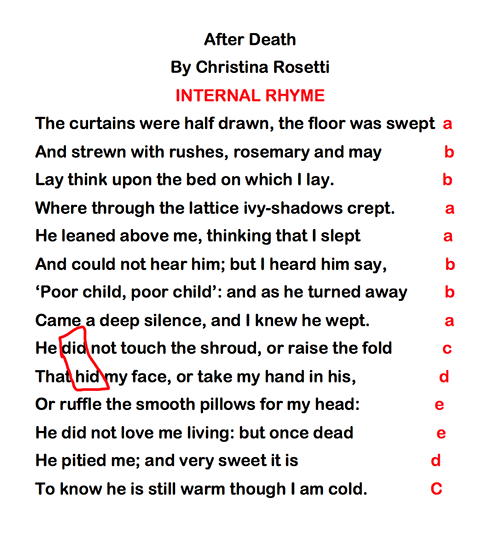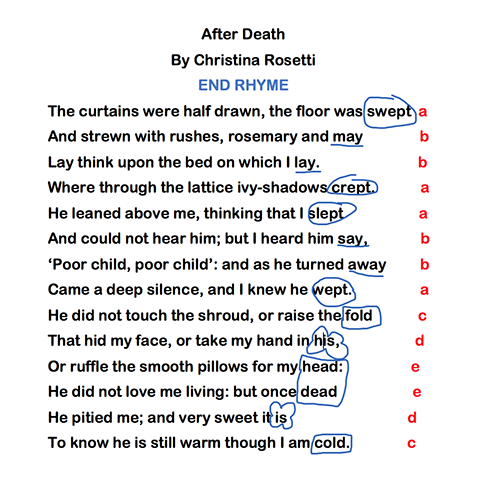"After Death"
by Christina Rossetti
A New Critical Theory Analysis
By Ashley Zizich

A rhyme is the repetition of similar sounding syllables, and the rhyme scheme is determined by the rhyme of the last word of each line. The first end rhyme always starts with "A". If the last word in the second line does not rhyme with the first line, then it will be labeled "B". Repeat these steps with each line of the poem. Label each matching sound with the same letter. In determining the rhyme scheme in the sonnet "After Death", I looked at the last word of each line. "swept" does not rhyme with "may" so "swept" is labeled with "A" and "may is labeled with "B". The rhyme scheme did not change until line 9, with the word "fold", making that line a "C" rhyme. Petrarchan sonnets almost always follow the same rhyme scheme of: abbaabba, but can vary from poem to poem. Determining the rhyme scheme first, helps in determining the type of poem as well. This poem is a Petrarchan Sonnet with 14 lines, written in iambic pentameter with an odd rhyme scheme and 10 syllabic on each line.

While the sonnet does not hold much in terms of internal rhyme, it is also important to note it as well as the rhyme scheme. Rhyme is the repetition of the ending sound of two or more words, such as cat and bat. Both words sound similar because they end in "at". Internal rhyme in poetry is a rhyme that appears in the middle of a line of a poem. An example of internal rhyme in the sonnet "After Death" is in lines 9 and 10, the words "did" and "hid".
In modern poetry, there is not often use of end rhyme, instead internal rhyme is used to create a quality of musicality to the poem.
Function of an internal rhyme is to heighten the poem's effect and make the poem more unified with a rhyming aspect within. Internal rhyme adds to the meaning of words within the poem.
An internal rhyme can be held within the same line. A good example of this is Edgar Allen Poe's "The Raven". "Once upon a midnight dreary, while I pondered weak and weary," The words "dreary", "weak" and "weary" are all within the same line, and create a musical rhyme.

The end rhyme in the sonnet also help determine the rhyme scheme. each rhyme is outlined in a circle, an underline, a square, and a bubble. Singing a song or reading a certain poem aloud, the reader must have encountered end rhymes, because these are a common type of rhyming pattern used in a poetic structure. End rhyme occurs when the last syllables or words in two or more lines rhyme with each other. It is also known as “tail rhyme”.The lines ending in similar sounds are pleasant to hear, and give musical effect to the poem or song.
Rhyme is the repetition of the final sound or sounds of a word. For example, "may" rhymes with "lay," and "swept" rhymes with "crept" in the sonnet. In traditional verse, as a Petrarchan sonnet, these end rhymes often form patterns that repeat over and over.
The Importance of Rhyme
Rhyme, along with meter, helps make a poem musical. In traditional poetry, a regular rhyme aids the memory for recitation and gives predictable pleasure. A pattern of rhyme, called a scheme, also helps establish the form. The rhymes in this sonnet help to drive the meaning of death.